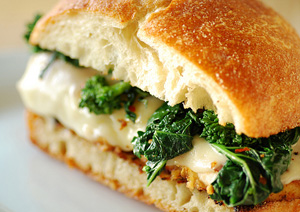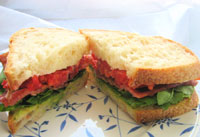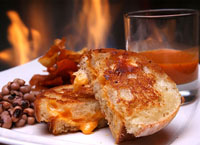 How did chicken sandwiches become so popular in the U.S.? Supply and demand. The emergence of large scale chicken processing companies such as Perdue and Tyson in the 1920’s and 1930’s respectively, helped propel chicken’s popularity in America. With such easy availability, chicken prices decreased, consumption increased, and chicken became a steady part of the American diet.
How did chicken sandwiches become so popular in the U.S.? Supply and demand. The emergence of large scale chicken processing companies such as Perdue and Tyson in the 1920’s and 1930’s respectively, helped propel chicken’s popularity in America. With such easy availability, chicken prices decreased, consumption increased, and chicken became a steady part of the American diet.
With many families cooking whole chickens, leftovers became standard lunch fare. Sliced leftover chicken meat became a favorite filling for sandwiches (and was the original filling for the classic club sandwich).
Fast food chicken sandwiches as we know them originated in 1967, when Truett Cathy, founder of the Atlanta based restaurant chain Chick-fil-A, introduced the chicken sandwich -- a perfectly crispy-on-the-outside, juicy-on-the-inside breaded boneless breast of chicken served on a toasted buttered bun with dill pickle chips. Whether it's fact or fiction, Cathy claimed that pickles were the only condiment he had on hand, and to his delight, were a big hit with consumers. Other fast food chains quickly followed suit. Then in the late 1980's and early '90's the grilled chicken sandwich emerged as a healthier alternative to the fried original.
 I don't know if Mae West ever ate a Cobb Salad, but I bet she would
have loved it. After all, she was the one who said "too much of a good
thing is wonderful". A Cobb Salad begins with a bed of Romaine lettuce,
think of it as your basic crunchy blank canvas.
Resting on the greens are strips of toppings – luscious chunks of
avocado, juicy fresh tomato, crumbles of rich blue cheese, hard boiled
eggs and chunks of chicken breast. Frankly I've always found the
chicken to be superfluous, but maybe that's just me.
I don't know if Mae West ever ate a Cobb Salad, but I bet she would
have loved it. After all, she was the one who said "too much of a good
thing is wonderful". A Cobb Salad begins with a bed of Romaine lettuce,
think of it as your basic crunchy blank canvas.
Resting on the greens are strips of toppings – luscious chunks of
avocado, juicy fresh tomato, crumbles of rich blue cheese, hard boiled
eggs and chunks of chicken breast. Frankly I've always found the
chicken to be superfluous, but maybe that's just me.

 “I’m hungry. Can someone please help me? Please. This is serious. I haven’t eaten since early this morning. Please.” The plea came from a diminutive man I had just rushed passed on 8th Avenue in New York City. He was wearing a grey cap pulled down over his forehead and held a tattered white plastic shopping bag. It was 12:30 a.m. A hard March wind was blowing through Chelsea and everyone who passed this pleading man, was hurrying to someplace warm, including me.
“I’m hungry. Can someone please help me? Please. This is serious. I haven’t eaten since early this morning. Please.” The plea came from a diminutive man I had just rushed passed on 8th Avenue in New York City. He was wearing a grey cap pulled down over his forehead and held a tattered white plastic shopping bag. It was 12:30 a.m. A hard March wind was blowing through Chelsea and everyone who passed this pleading man, was hurrying to someplace warm, including me.  It's hard to believe that baseball season is about to begin again. I
see bits and pieces on the news about players reporting to Spring
training. I see photos of fathers and sons dressed up in their player's
favorite jersey, watching an early practice, hoping to get an
autograph. The excitement is building of those summer nights at the
ballpark; that all-American warm, fuzzy feeling most folks associate
with baseball.
It's hard to believe that baseball season is about to begin again. I
see bits and pieces on the news about players reporting to Spring
training. I see photos of fathers and sons dressed up in their player's
favorite jersey, watching an early practice, hoping to get an
autograph. The excitement is building of those summer nights at the
ballpark; that all-American warm, fuzzy feeling most folks associate
with baseball. Not that anyone needs to be reminded, but April is National
Grilled-Cheese Sandwich Month. In honor of this auspicious occasion, we
bring you our picks for New York’s best grilled cheese, from
Keller-crafted high to Kraft-oozing low.
Not that anyone needs to be reminded, but April is National
Grilled-Cheese Sandwich Month. In honor of this auspicious occasion, we
bring you our picks for New York’s best grilled cheese, from
Keller-crafted high to Kraft-oozing low.
 How did chicken sandwiches become so popular in the U.S.? Supply and demand. The emergence of large scale chicken processing companies such as Perdue and Tyson in the 1920’s and 1930’s respectively, helped propel chicken’s popularity in America. With such easy availability, chicken prices decreased, consumption increased, and chicken became a steady part of the American diet.
How did chicken sandwiches become so popular in the U.S.? Supply and demand. The emergence of large scale chicken processing companies such as Perdue and Tyson in the 1920’s and 1930’s respectively, helped propel chicken’s popularity in America. With such easy availability, chicken prices decreased, consumption increased, and chicken became a steady part of the American diet.